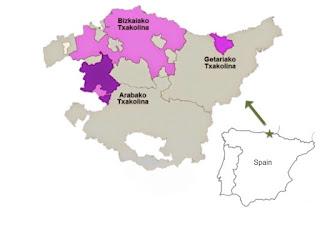Welcome to the Basque language. DO Getariako Txakolina is the appellation, Hondarrabi Zuri a white wine grape, and Blai Txakolina a winery.
 Founded in 1989, and extended in 2007, Getariako Txakolina is a DO wine zone within Pais Vasco (the Basque Country) in northern Spain. There are three recognized areas for Txakoli (pronounced chac-o-lee and translated to 'wine made from a village' or 'wine village'). The other two areas are Arabako Txakolina and Bizkaiko Txakolina.
Founded in 1989, and extended in 2007, Getariako Txakolina is a DO wine zone within Pais Vasco (the Basque Country) in northern Spain. There are three recognized areas for Txakoli (pronounced chac-o-lee and translated to 'wine made from a village' or 'wine village'). The other two areas are Arabako Txakolina and Bizkaiko Txakolina.
The vines are grown bordering the Atlantic coast to the north and France and the Pyrenees 30 kilometers to the east. These vineyard sites are greatly affected by their proximity to the Atlantic Ocean where the cold influences are felt in all three areas. However, in Getariako Txakolina, the cold influences are moderated by warmer coastal hills. And, as opposed to the other two Txakoli areas, Getariako Txakolina receives a high level of rainfall – an average of 63 inches a year. Here most vineyards are located on the gentle southeast-facing slopes and foothills of the Pyrenees where the soil is chalky containing rich, organic material.

The Hondarrabi Zuri grape accounts for nearly 95% of total plantings in Getariako Txakolina and is named for a town in the region named Hondarribia. The word "Zuri" means white in the Basque language. This grape excels in the colder conditions near the Atlantic and creates light, citrus, and white fruit wines with noticeable herbal and saline notes.
Blai Txakolina is a producer we met at a recent Wines of Spain tasting in Washington D.C. They source from many wine growers in the area which allows them to utilize different vineyards that offer the grapes and conditions appropriate to their production style. Coastal grapes offer freshness and these are blended with more intense inland Gipuzkoa grapes. They utilize Oñati vineyards with their gentle slopes facing south as well as vineyards where the slopes descend towards the sea in the heart of Getaria.
Here are several of the Hondarrabi Zuri wines we tasted and hope to visit during a Camino de Santiago pilgrimage.
Blai Blanco Txakoli de Getaria
"Made with grapes from coastal Getaria vineyards 80% and inland Oñati vineyards 20%, both 100% Hondarrabi Zuri with an early ripening point to accentuate its freshness. Worked under strict temperature control, it is aged on its lees for 3 months before proceeding to cleaning and bottling." Expect citrus, saline, and fresh acidity.
Blai Rosado Txakoli de Getaria
"Made with grapes from coastal Getaria vineyards, 30% Hondarrabi Zuri and 70% Hondarrabi Beltza with an early ripening point to accentuate its freshness and achieve a slight pink color during pressing. Worked under strict temperature control, it is aged on its lees for 3 months before proceeding to cleaning and bottling."
Herbaceous strawberries are followed by astringent and effervescent acidity.
Blai Itsas-aparra Espumoso Txakoli de Getaria
"Made with grapes from inland Oñati vineyards 100% Hondarrabi Zuri with an early ripening point to accentuate its freshness. Worked like the white Blai txakolina, fermentation is stopped at the right time so that the residual sugar is what is later referred to in the bottle during the traditional foaming process. It is in rhyme, during the maturation process in the bottle, until the sensory and physical-chemical analyzes are adequate for its disgorgement and, subsequent and definitive corking."
Think sparkling Blai Blanco
Blai Orange Txakoli de Getaria
An earthier version of Hondarrabi Zuri
